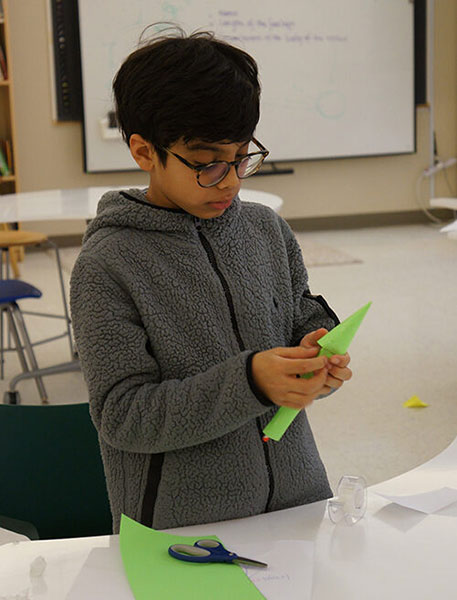New STEAM classes explore aerospace and civil engineering
At EMS, we follow the 4 C’s — courtesy, consideration, cooperation, and compassion — in everything we do. These tenants are ingrained in our community interactions and are helping us build a brighter future with students who will become role models for younger generations. But there is another set of 4 C’s that our students are learning in the Engineering for Kids program taking place in Little School during the winter and spring semesters.
Students in first through fourth grade are using the 4 C’s of engineering — collaboration, communication, creativity, and critical thinking — to find solutions to various aerospace and engineering challenges. Classes begin with a discussion about the project’s background, history, and the scientific principles behind it, then students go through the five stages of the engineering design process: stating a problem, brainstorming a solution, designing a plan, building a model, and testing.


Students across Little School are exploring the same set of projects, although with differing levels of complexity based on grade level. Projects covered include the study of parachutes, airplanes, rockets, lunar landings, and how cities are engineered. Each lesson dives into other subjects covered in Little School, including math problems, helping to promote learning across disciplines.
For their recent rocket unit, students learned the science behind how rockets work and key concepts such as breaking gravitational force, thrust, and interplanetary science. They discussed a problem in rocket aerodynamics, drew force diagrams with solutions to the problem, discussed how to launch their rockets, and brainstormed ideas for improvement. Individually, they used innovative thinking to design and build a model to scale that they tested by launching on our courtyard patio. After seeing the results, they explored and addressed any engineering problems, making improvements as they continued their process of iterative design.
“Our STEAM-based curriculum offers hands-on project learning to students. They are using their creativity and critical thinking and problem-solving skills to design, build, and test their projects,” says Kunal Aggarwal, owner of Engineering For Kids of West New York and Google software engineer, who teaches the classes with Mina Zainab, electrical engineer and STEAM director for Engineering for Kids.
Aggarwal handcrafted the Engineering For Kids curriculum during his time as an adjunct professor at Fordham University, where he taught a graduate course in computer science. He based it on the research projects he developed while at the university. “I realized some students didn’t have the basic curiosity or knowledge about subjects outside their major and were only focused on one aspect of their college career,” he says, “I started to think about ways we could teach engineering and scientific principles at an early age.”


“I teach the students, but I learn from them too,” says Aggarwal, who described how an EMS fourth-grader created a “double” double-decker parachute with two double-decker parachutes side-by-side after learning about parachutes in the Engineering For Kids class. Her uniquely-designed parachute was repeatedly dropped from 6 feet high with increasing weight (dice) added each time. The project held up to five dice and “broke a record,” Aggarwal says. “It worked really well.”
One goal for Zainab in the Engineering For Kids classes is to help girls feel comfortable with engineering principles at a young age. “I want it to feel natural to them to pursue a career in engineering as they get older,” she says. “This field of science should be accessible to everyone.”
Both Aggarwal and Zainab agree that it’s amazing to see the confidence in EMS students as they build something and see that it works. “The skills these students are learning now — communication, creativity, critical thinking, and innovation — will help prepare them for the future, for jobs that may not even be created yet. It’s important to Inspire the next generation of engineers,” says Aggarwal.
Lifelong Learning is at the Heart of The Elisabeth Morrow School Experience
Whether it’s learning an instrument, participating in a lively class discussion, or building a prototype with a laser printer, students continually cultivate their interests, expand their skills, and develop their passion for learning throughout their early childhood, lower school, and middle school years at EMS.


